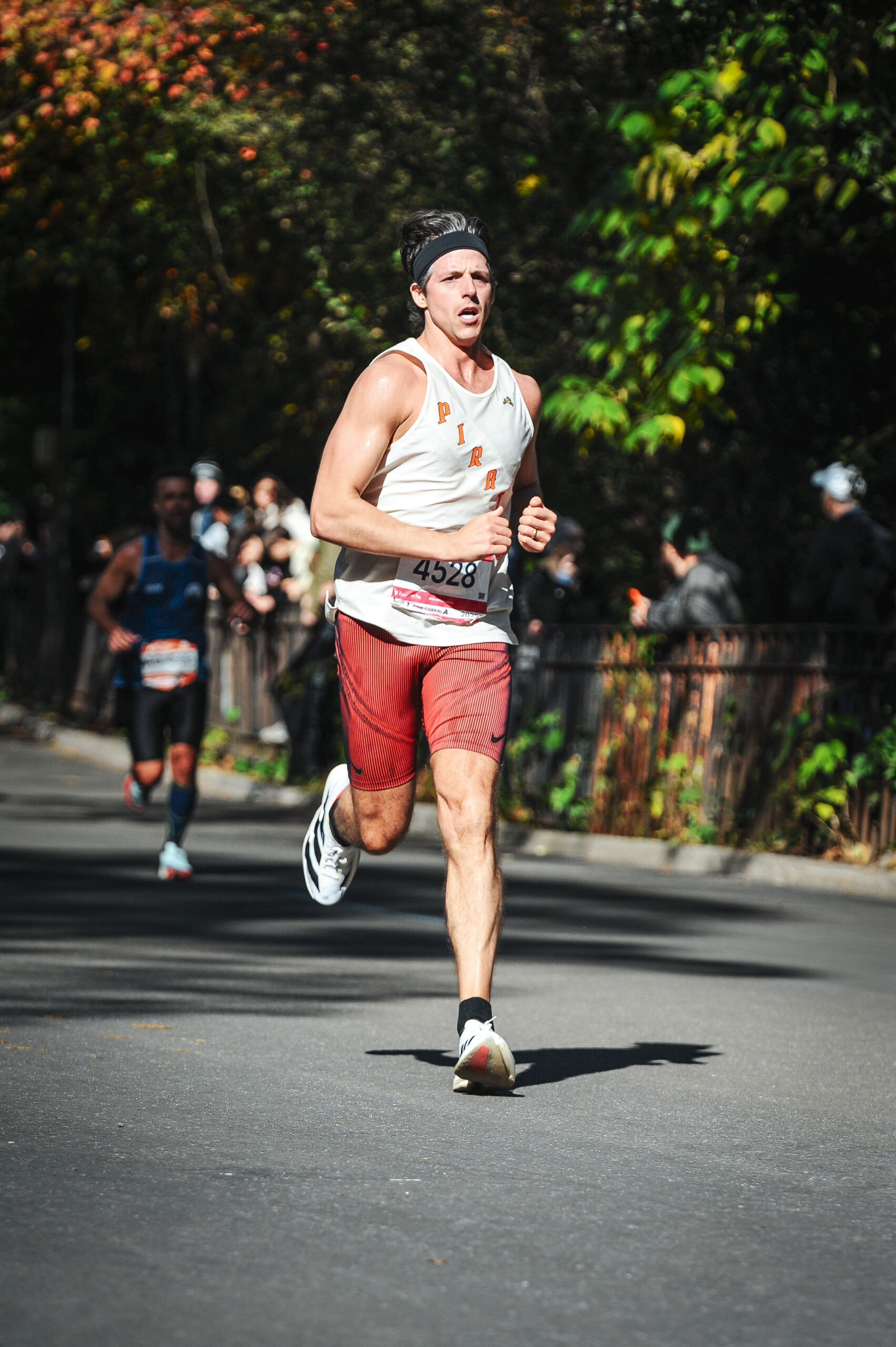On Sunday November 2nd, I joined nearly 60,000 people in doing something completely irrational.
We paid hundreds of dollars, trained for months, sacrificed weekends and sleep — and then ran 26.2 miles across New York City, pushing our bodies to the edge of failure for a medal, a mylar blanket, and a finish time many will forget.
From the outside, it makes no sense.
From a behavioral-science perspective, it’s the perfect experiment.
Because the NYC Marathon isn’t just a race — it’s a living experiment in what truly drives human behavior. Every cheer, every sign, every surge of adrenaline on First Avenue and moment of doubt on the Queensboro Bridge is a data point in motivation, identity, and belief.
The NYC marathon teaches you something critical: the gap between what people should do and what they actually do comes down to language.
As someone who practices behavioral science and language strategy for a living — and who has run the NYC Marathon five times — the race offers a masterclass in communication that brands, leaders, and organizations can learn from.
Here are the most powerful behavioral and language lessons from the 26.2 miles.

1. The Starting Line: Don’t think, just do it.
It’s 6:00 AM. You’re on Staten Island in the dark, freezing, anxious, questioning every decision that led you here. To get to that starting line, you have to override one of the brain’s biggest barriers: overthinking.
Running rewards action over analysis. Communication does too.
Nike’s “Just Do It” endures because it collapses the gap between intention and action. Thinking is friction. Action is clarity. By Mile 24, no one is thinking their way forward. You act, adjust, respond. You trust your training. You focus on one step at a time.
The lesson: Remove friction. Remove overthinking. Move people toward action. Because usually the biggest barrier to change is simply the space between intention and step one.


2. Brooklyn: Social Norms at Scale
If you ever doubt the power of social norms, stand anywhere along Bedford Ave in Brooklyn on marathon morning.
You’ll see thousands doing something evolutionarily irrational — running 26.2 miles — cheered on by two million strangers who believe it’s completely normal. For one day, a city of 8 million acts as one supportive organism. Strangers cheer for strangers.
When you hear “New York shows up!” or see a sign that says, “This is what strong looks like,” you’re reminded: you’re part of something bigger. That sense of belonging is the most potent motivator in human behavior.
The same dynamic applies to communication. When brands or leaders tap into identity and belonging, they unlock action. People don’t act because they’re told to. They act because the behavior confirms who they already believe they are.
The lesson: Don’t see a product. Sell a membership in a tribe.


3. The Blue Line: Design as a Silent Communication System
The NYC Marathon course is a communication system where design, structure, and language guide behavior without saying a word.
The blue line painted along the route is a nonverbal cue that keeps runners aligned and reduces cognitive effort. Mile markers act as commitment devices, translating an abstract goal (26.2 miles) into digestible chunks (“just one more mile”). Even the borough transitions tell an emotional story: optimism (Brooklyn), grit (Queens), doubt (Bronx), triumph (Manhattan).
Good communication works the same way. It’s not about overwhelming people with information. It’s about structuring the experience, so your audience always knows where they are, where they’re going, and why it matters.
The lesson: The best communication is invisible. It guides without demanding attention.

4. Mile 16 (Queensboro Bridge): The Power of Reframing
Every runner knows this truth: the most important conversations during a marathon are the ones happening inside your own head.
Somewhere on the Queensboro Bridge — crowd less and silent, windswept, legs heavy — your brain starts negotiating. And what you tell yourself becomes a physiological cue.
- “My legs are dead” → signals threat → tightens your body
- “My legs are working hard” → signals effort → keeps you loose
This tiny linguistic shift can determine whether you fade or fight through. Exercise scientist Samuele Marcora found the same in his powerful study, “Talking Yourself Out of Exhaustion.” Runners who practiced short motivational self-talk with phrases like “Stay strong,” “Relax and push,” or “You’ve got this” didn’t suddenly gain fitness, but they changed their perception of effort. Reframing discomfort literally changes how your body processes effort.
Language changes how hard something feels — and how hard it feels determines how long you can keep going.
The lesson: Self-talk isn’t fluff. It’s cognitive regulation. Words shape behavior. If the marathon teaches anything, it’s that words shape performance.

5. Mile 20: Stories Move People, Not Data
Every runner on that starting line has a story.
For me, running has always been about my brother. He passed away from bacterial meningitis, and I started running in 2019 in his memory. He’s the reason I lace up. He’s the quiet voice in the back of my mind at Mile 20. What began as tribute became a way to carry his spirit with me — one mile, one race, one finish line at a time.
Now, it’s evolved into something more: I run to inspire my kids — to show them what it looks like to chase something hard and challenge yourself to grow.
Every stride becomes a sentence in a story only you can tell.
Behavioral scientists call this narrative identity — the idea that we make sense of our lives by turning experience into story. We don’t remember the Strava data; we remember the meaning we assign to them.
That’s why the marathon resonates so deeply. It gives shape to struggle. It turns pain into purpose. It allows you to say, “This is who I am, and this is why I keep going.” From the outside, the marathon looks like a race of bodies. From the inside, it’s a race of stories — 50,000 individual narratives converging into one collective arc of perseverance.
The lesson: You can’t move people with information. You move them with meaning. And when the story becomes personal, it becomes powerful enough to carry someone through 26.2 miles — or through organizational change.


6. Mile 24: he Behavioral Economics of Suffering
Just after turning into Central Park, my calves started to seize. Sharp, persistent discomfort whispered: One wrong move and you’re done. The thoughts came fast: Will my leg hold up? Can I push through? What if I stop?
Then I reframed it.
You’ve done the work. You’ve prepared for this. This is what it’s supposed to feel like.
That simple mental shift turned pain from enemy into metric — proof I was exactly where I needed to be. My stride opened. My focus snapped from my calves to the finish line.
Behavioral economist Dan Ariely demonstrated this in his burn-unit research: people’s perception of pain is malleable. When patients framed their discomfort as purposeful — a sign of healing — their distress dropped sharply, even though pain intensity never changed.
The lesson: the same sensation can be either a cost or an investment depending on how you frame it. When pain becomes progress, you stop spending energy fighting it and start using it to finish.


7. Mile 26: Communicating that Moves
Somewhere along the race, you hear a thousand cheers. Most blur together. But then one cuts through — your name shouted by a stranger, the right words at the right moment. It doesn’t just reach your ears. It reaches your legs. You move differently.
That’s the difference between communication that talks at people and communication that moves them.
The messages that mattered most shared a few traits:
- Simple. Easy to process when you’re depleted.
- Specific. “One more hill to the park!” beats “Keep going!”
- Personal. “Jason, you’ve got this!” changes physiology.
- Emotional. You feel belief before you analyze it.
Most messages get lost because they try to inform instead of inspire; they overload rather than energize.
The lesson: You can’t think people into action. You can only move them there.

8. The Finish Line: The Peak End Rule
Psychologically, people don’t remember the full marathon. They remember:
- The hardest moment (the peak)
- The last moment (the end)
Behavioral science calls this the Peak-End Rule, and the NYC Marathon nails both: the emotional low of Queensboro bridge, and the emotional high of Central Park and crossing the finish line.
This is why people cry at the finish line. It’s not just exhaustion — it’s emotional resolution.
The lesson: Every brand experience, every customer journey, every speech, every interaction can benefit from this principle:End the experience with a powerful emotional payoff.

What the NYC Marathon Teaches Us About Moving People
The NYC Marathon reminds us that communication isn’t about what you say — it’s about what people feel, believe, and do as a result.
Runners don’t finish because of rational arguments or statistics. They finish because of identity, emotion, story, and the right words said at the right time.
In behavioral terms:
- Motivation is social. We act when we see ourselves in a group.
- Action is emotional. Logic informs; emotion moves.
- Communication is contextual. The right message at the wrong time is just noise.
If you want to move people — whether they’re customers, employees, or stakeholders — speak to who they are, show them progress, and meet them at Mile 20, not Mile 1.
Because the finish line isn’t about information. It’s about transformation.






